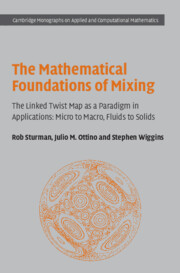 The Mathematical Foundations of Mixing
The Mathematical Foundations of Mixing Published online by Cambridge University Press: 03 February 2010
This chapter establishes the mathematical foundations on which to build. The key concepts and results from ergodic theory are given, forming an ordered list of behaviours of increasing complexity, from ergodicity, through mixing, to the Bernoulli property.
Introduction
We will mostly be interested in the simplest mixing problem: the mixing of a fluid with itself. This serves as a foundation for all mixing problems. Practically, we can think of placing a region, or ‘blob’ of dye in the fluid, and asking how long it takes for the dye to become evenly, or uniformly, distributed throughout the entire domain of the flow. We will need the mathematical machinery to make this question precise and quantitative. We will first need a framework to mathematically describe, measure and move regions of fluid. To do so we will introduce simple ideas and definitions from topology, measure theory and dynamical systems. In particular, notions of set theory from topology correspond naturally to properties of an arbitrary region of fluid, such as its boundary, interior and connectedness. Measure theory provides the tools necessary to measure the size of a region in a generalized and consistent way. The basis of the field of dynamical systems is the study of the evolution of some system with time, and these ideas can be applied directly to the application of moving fluid. These are by now all well-established techniques in the study of fluid mechanics (see for example Ottino (1989a)).
To discuss mixing of fluid we will need the area of mathematics known as ergodic theory. This provides a framework in which many physically relevant pieces of the mixing problem can be fruitfully studied.
To save this book to your Kindle, first ensure no-reply@cambridge.org is added to your Approved Personal Document E-mail List under your Personal Document Settings on the Manage Your Content and Devices page of your Amazon account. Then enter the ‘name’ part of your Kindle email address below. Find out more about saving to your Kindle.
Note you can select to save to either the @free.kindle.com or @kindle.com variations. ‘@free.kindle.com’ emails are free but can only be saved to your device when it is connected to wi-fi. ‘@kindle.com’ emails can be delivered even when you are not connected to wi-fi, but note that service fees apply.
Find out more about the Kindle Personal Document Service.
To save content items to your account, please confirm that you agree to abide by our usage policies. If this is the first time you use this feature, you will be asked to authorise Cambridge Core to connect with your account. Find out more about saving content to Dropbox.
To save content items to your account, please confirm that you agree to abide by our usage policies. If this is the first time you use this feature, you will be asked to authorise Cambridge Core to connect with your account. Find out more about saving content to Google Drive.